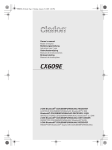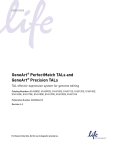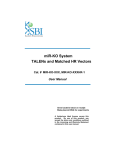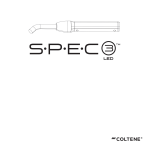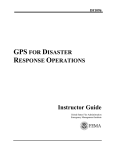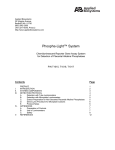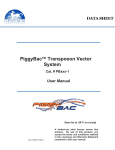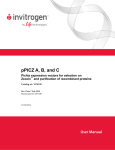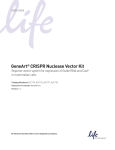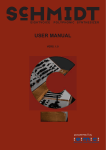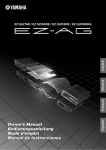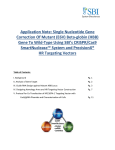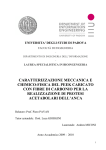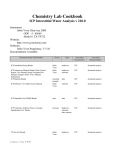Download EZ-TAL™ Assembly Kit
Transcript
EZ-TAL™ Assembly Kit Cat# GExxxA-1 User Manual Store kit at -20°C on receipt A limited-use label license covers this product. By use of this product, you accept the terms and conditions outlined in the Licensing and Warranty Statement contained in this user manual. EZ-TAL™ Assembly Kit Cat. # GExxxA-1 Contents I. Introduction ..............................................................................2 A. Overview of TALE technology ................................................2 B. TALEN technology ..................................................................2 C. TALE-TF technology ...............................................................3 D. Overview of the Products........................................................3 E. List of Components .................................................................4 F. Additional Required Materials .................................................5 II. Experimental Design................................................................6 A. Design of TALE target sequence ............................................6 B. Choice of your TALEN and TALE-TF vectors .........................6 III. TALE assembly protocol ..........................................................7 A. Selection of Monomers ...........................................................7 B. Assembly of Multimers ............................................................8 C. Exonuclease Treatment ..........................................................9 D. PCR Amplification of Multimers ..............................................9 E. Gel purification and normalization of multimer amplicons ....10 F. Assembly of multimers into vector ........................................11 G. E. coli transformation ............................................................13 IV. Confirmation of TALE assembly ............................................13 A. Colony PCR and agarose gel analysis .................................13 B. TALE construct sequencing ..................................................16 V. TALE construct validation data ..............................................16 A) Validation and QC of TALE construct ...................................16 B) Sequence confirmation of final TALE construct ...................16 C) Building TALE Construct Vector files ...................................17 VI. Troubleshooting .....................................................................18 A. Faint/missing multimer band with high-molecular smearing .18 B. Colony PCR does not reveal correct band ...........................18 C. Sequence error in assembled TALE.....................................18 VII. References ............................................................................18 VIII. Appendix ................................................................................19 888-266-5066 (Toll Free) 650-968-2200 (outside US) Page 1 System Biosciences (SBI) User Manual A. General Information and Protocol for EZ-TALTM End-Monomer Kit (Cat #GE900A-1) 19 B. Example TALEN design against GFP target ........................20 C. Related Products ..................................................................22 D. Technical Support .................................................................22 IX. Licensing and Warranty information ......................................23 I. Introduction A. Overview of TALE technology Transcription activator-like effectors (TALEs) are a class of naturally occurring transcription effectors that recognize specific DNA sequences to modulate gene expression. First identified in the plant pathogen Xanthomonas sp., the modularity of TALEs enables sequence-specific perturbation of gene function and offers broad applications in genetic and epigenetic studies. The TALE binding domain is defined by a simple, yet elegant code of tandem repeat sequences (Repeat Variable Domains or RVDs) that allows for programmable generation of customized TALEs that bind to any DNA sequence with high specificity (Fig.1). Compared to other gene targeting technologies such as zinc-finger nucleases (ZFNs) and meganucleases, TALEs offer the researcher more latitude in selecting potential DNA targets, ease in design, reliability and predictability of DNA binding, and unmatched specificity . Taken together, these underlying features of TALEs provide a new set of powerful genetic engineering tools for studying gene function in target organisms. Fig. 1: Modular organization of TALE effector protein and code that specifies DNA binding Due to the modular structure of TALEs, the TALE DNA-binding domain can be efficiently combined with functional domains for targeted gene disruption such as the FokI nuclease domain (TALEN) or gene activation such as VP64 (TALE-TA), or gene repression such as KRAB/ ERA (TALE-TR). Both TALEN and TALE-TA/TR modules have been successfully applied to gene disruption or gene regulation in a number of species (Hockemeyer et al., 2011; Li et al., 2011; Li et al., 2012b; Liu et al., 2012; Mahfouz and Li, 2011; Moore et al., 2012). B. TALEN technology When fused to a FokI cleavage domain, TALE nucleases (TALENs) recognize specific DNA sequences as specified Page 2 ver. 4-130501 www.systembio.com EZ-TAL™ Assembly Kit Cat. # GExxxA-1 by the internal tandem repeats present in the TALEs. Binding of target DNA by two TALENs, typically spaced 15 to 30 bp apart, allows FokI to dimerize and create a targeted chromosome break. This process leads to recruitment of cellular machinery involved in the non-homologous end joining (NHEJ) pathway to repair the damaged duplex, resulting in either small deletions or insertions that leads to disruption of target gene function (Fig. 2). By fully leveraging TALEN-based gene targeting, researchers have been able to successfully knockout genes in cultured somatic cells, with targeting efficiencies ranging from 20~80% (single or biallelic modification) Fig. 2: Schematic of TALEN-based gene targeting C. TALE-TF technology Another key application for TALEs is the targeted activation and repression of target genes in cells by fusing of a transactivation or a repression domain to TALE DNA binding domain. The resulting construct (TALE-TF) is a powerful tool to selectively modulate endogenous gene expression in eukaryotic cells with exquisite specificity (Li et al., 2012a; Mahfouz et al., 2012). An example of such system is illustrated here, using a dual-fluorescent and luciferase reporter system to assess TALE-TA (activation) functionality (Fig. 3) Fig. 3: Reporter data illustrating linearity of fluorescence and luciferase activity levels upon TALE-TA binding to TALE response elements D. Overview of the Products SBI’s EZ-TAL™ Assembly Kit consists of a simple, straightforward 2-day protocol designed for rapid and accurate construction of customized TALEN and TALE-TFs (Fig.4) targeting DNA sequences of 20 bp in length. 888-266-5066 (Toll Free) 650-968-2200 (outside US) Page 3 System Biosciences (SBI) User Manual Fig. 4. General overview and workflow of TALE construction E. List of Components Each EZ-TALTM Kit contains the following components with enough material to perform a minimum of 6 and a maximum of 12 TALE assemblies, depending on the target sequence redundancy. The products are supplied in two boxes. Please examine the contents of each box upon receiving to verify that all of the components are present. Please briefly centrifuge tubes prior to use. Page 4 ver. 4-130501 www.systembio.com EZ-TAL™ Assembly Kit Cat. # GExxxA-1 Fig. 5. Layout of the color-coded components in each of the boxes for the EZ-TALTM kit Total volume 7 L each 15 L each 100 L 100 L 100 L 50 L 30 L 100 L 80 L 15 L 150 L Description Monomers (A, T, G, C, 1-18) Vector Plasmid DNA (4 tubes) Sequencing primer SF-1 (fwd-1) Sequencing primer SF-2 (fwd-2) Sequencing primer SR (rev) Multimer primer pair BsmBI restriction enzyme Combo Buffer I DTT T7 Ligase ATP Concentration 15 ng/L 100 ng/L each 10 M 10 M 10 M 10 M each 10 U/ L 10 x 10 mM 3000 U/L 10 mM 100 L 100 L 50 L 20 L 400 L 50 L 12 L 60 L 50 L 50 L Exonuclease Exo buffer dNTP High-fidelity DNA polymerase PCR buffer dNTP BsaI restriction enzyme Combo Buffer II BSA Colony-PCR primer mix 10 U/L 10 x 25 mM each 5x 25 mM each 20 U/L 10 x 10x 10 M each Vials are shipped on blue ice/dry ice and should be stored at -20°C upon receipt. Properly stored samples are stable for 6 months from the date received. F. Additional Required Materials 1) Taq polymerase (e.g. New England BioLabs, Ipswich, MA, #MO267X) 2) MinElute Gel Extraction Kit (Qiagen, Valencia, CA, #28606) 3) Qiaprep Spin Miniprep Kit (Qiagen, Valencia, CA, #27106) 888-266-5066 (Toll Free) 650-968-2200 (outside US) Page 5 System Biosciences (SBI) User Manual 4) High transformation efficiency Escherichia coli (e.g. One Shot Stbl3 chemically competent E. coli (Life Technologies # C7373-03) or similar competent cells compatible with ccdB vectors)) 5) SOC medium (Life Technologies, #46-0700) 6) LB-Carbenicillin Plates (Teknova, Hollister, CA, #LI008) 7) LB Broth (Teknova, #L8000) 8) Carbenicillin (Teknova, #C2130) 9) Low DNA-Mass Ladder (Life Technologies, #10068-013) *10) EZ-TALTM Special End-Monomer Kit (System Biosciences, #GE900A-1) *Required for building TALE constructs targeting less than 20bp (e.g. 14-19bp) II. Experimental Design A. Design of TALE target sequence TALE target sequences with minimal off-target effects can be efficiently designed using a number of online tools such as TALENTargeter 2.0 (Doyle et al., 2012) and idTALE (http://idtale.kaust.edu.sa/). An example of using the TALENTargeter 2.0 software to design specific TALEN pairs against Green Fluorescent Protein (GFP) gene is illustrated in the Appendix (Section VIII.A). In general, the design of TALENs requires a pair of proteins that bind adjacent DNA sites that are spaced approximately 15-30bp apart for optimal binding, dimerization, and cutting of the targeted sequence by FokI endonuclease (Cermak et al. 2011). By contrast, TALE-TF applications requires the design of only a single effector protein. The length of DNA binding sequences may vary, typically ranging from 14 to 20 bp. In humans, designing of longer TALEN and TALE-TF constructs (e.g.18-20 bp) appears to increase targeting specificity, resulting in more relevant phenotypes (Reyon et al., 2012). SBI’s standard EZ-TALTM Assembly Kit is designed for target sequences which are 20 bp in length. For target sequences less than 20 bp (e.g. 14-19 bp), we offer a special End-Monomer Kit (Cat #GE900A-1) which allows flexibility in the length of the sequence being targeted by the use of specially-designed terminal monomers that define the end of the multimer. Please refer to the description and detailed protocol for the End-Monomer kit located in Section VIII. Appendix for additional details. B. Choice of your TALEN and TALE-TF vectors The appropriate vector backbone to clone-in the sequence-specific TALE construct are listed in Table 1. The choice of the vector backbone and promoter is dependent on the specific desired application (e.g. gene disruption or activation/repression). Please note that since the last base of each full TALE construct is vector encoded, all vectors come in four versions, containing an A, T, G, or C-specific half repeat sequence. Table 1. List of available TALE-TF and TALEN vector backbones TALE Vector CMV-TALEN-XX* (XX = NI, NG,HD, or NN) EF1α-TALEN-XX* (XX =NI, Promoter CMV Catalog # GE100A-1 EF1α GE120A-1 Page 6 ver. 4-130501 www.systembio.com EZ-TAL™ Assembly Kit NG,HD, or NN) MSCV-TALEN-XX* (XX = NI, NG,HD, or NN) CMV-TALE-TF-XX* (XX = NI, NG,HD, or NN) EF1α -TALE-TF-XX* (XX = NI, NG,HD, or NN) MSCV-TALE-TF-XX* (XX = NI, NG,HD, or NN) Cat. # GExxxA-1 MSCV GE140A-1 CMV GE500A-1 EF1α GE520A-1 MSCV GE540A-1 * Specifies RVD for the last DNA base of the target sequence, encoded in the TALE construct where NI = A, NG = T, HD = C, NN = G or A III. TALE assembly protocol A. Selection of Monomers Day 1: Total Time (5min) 1) Divide the target sequence of 14-20 nucleotides (from the output of TALE software tool) into three sets of multimers, excluding the first (5’) T and the last (3’) nucleotide, which is vector-encoded. Example: 20 nucleotide TALE target. Please note that the first 5’ T(here designated as T0) and the last 3’ G (here designated as G19) are NOT included in the multimer assembly reaction. The first binding nucleotide is always T, whose binding is not mediated by the RVD binding repeats but rather by the N-terminal flanking sequences. The last nucleotide binding is mediated by a half repeat, which is built into the vector. T0 | A1 T2 C3 G4 C5 C6 | T7 C8 T9 A10 G11 C12 | C13 A14 C15 T16 A17 A18* | G19 Red = Multimer 1, Green = Multimer 2, Gray = Multimer 3 Number below each base refer to the order in which each nucleotide is assembled (from 1-18). 2) Take the corresponding color-coded monomers from Box 1 of the EZ-TALTM kit according to the order above (except T0 and G19). 3) Centrifuge briefly and put them on ice in order. 888-266-5066 (Toll Free) 650-968-2200 (outside US) Page 7 System Biosciences (SBI) User Manual B. Assembly of Multimers Fig. 6. Schematic of the workflow for building individual multimers using provided monomers from the EZ-TALTM kit Day 1: Bench Time (30min), Total Time (3 hrs) 1) In a separate tube for each multimer, pipette 1 μL of each monomer per example shown below: Example Multimer Tube 1: Contains Monomers A1 + T2 + C3 + G4 + C5 + C6 Multimer Tube 2: Contains Monomers T7 + C8 + T9 + A10 + G11 + C12 Multimer Tube 3: Contains Monomers C13 + A14 + C15 + T16 + A17 +A18end 2) Prepare a master mix with components specified in Table 2. Reaction volumes are for 3 multimers + 1 to account for pipetting differences. 3) Add 4 L of mix to each multimer tube for a total of 10 L. Mix contents of each tube by pipetting up and down several times (DO NOT VORTEX!). Table 2. Components for multimer assembly (for 3 multimers +1 for overage, 4 reactions in total) Combo Buffer 4 µl DTT 4 µl ATP 4 µl BsmBI restriction enzyme 3 µl T7 Ligase 1 µl Total 16 µl 3) Place each multimer tube in a thermocycler and use cycling conditions specified in Table 3 for ~ 2.5 hours. Table 3. Thermocycler conditions for multimer assembly Page 8 ver. 4-130501 www.systembio.com EZ-TAL™ Assembly Kit Cat. # GExxxA-1 Cycle Number Temperature 1 Temperature 2 1-15 37°C, 5 min 20°C, 5 min Hold at 4°C C. Exonuclease Treatment Day 1: Bench Time (10min), Total Time (1.2 hrs) 1) To degrade any noncircular ligation products, prepare master mix from components specified in Table 4. Table 4. Components for exonuclease treatment (for 3 multimers +1 for overage, 4 reactions in total) Exo buffer 6 µl ATP 8 µl Exonuclease 6 µl Total 20 µl 2) Mix well by pipeting up and down several times (DO NOT VORTEX!), and add 5 L of master mix to each multimer tube, for a total volume of 15 L IMPORTANT: Follow the above procedure exactly - Do not change the reaction ratio and volume!! 3) Place each multimer tube in a thermocycler and use cycling conditions specified in Table 5 for 1 hour. Table 5. Thermocycler conditions for exonuclease treatment Cycle Number Temperature 1 Temperature 2 1 37°C, 30 min 70°C, 30 min Hold at 4°C D. PCR Amplification of Multimers Day 1: Bench Time (30min), Total Time (1.3 hrs) 1) To amplify each multimer, prepare master mix consisting of components specified in Table 6. Table 6. Components for multimer amplification (for 3 multimers + 1 for overage, 4 reactions in total) 888-266-5066 (Toll Free) 650-968-2200 (outside US) Page 9 System Biosciences (SBI) User Manual PCR buffer 40 µl DNA-grade Water 148 µl Multimer primer mix 4 µl dNTP 2 µl High-fidelity DNA polymerase 2 µl Total 196 µl 2) Mix well by pipeting up and down several times (DO NOT VORTEX!) Add 49 L of mix to 1 L of each multimer template, mix well by pipeting up and down several times 3) Perform PCR of each multimer mix using conditions specified in Table 7. Table 7. Multimer PCR conditions Cycle Number Denature 1 95°C, 2 min 2-36 95°C, 20 s Anneal Extend 61°C, 20 s 72°C, 30 s 37 72°C, 3 min Hold at 4°C E. Gel purification and normalization of multimer amplicons Day 2: Bench Time (1 hr), Total Time (2 hrs) 1) Load 50 L of each amplified multimer in 1 large well or 2 medium-sized wells on a 1.5% agarose gel, and include a molecular size marker, preferably one with known DNA mass for each band in the marker for normalization (see below) 2) Run gel at 15V/cm or until there is clean separation of each band in the ladder (distinct bands appears when the blue dye is near the edge of gel). Page 10 ver. 4-130501 www.systembio.com EZ-TAL™ Assembly Kit Cat. # GExxxA-1 Fig. 7. Agarose gel images of multimer amplicons pre- and post gel purification showing distinct multimer bands 3) Capture gel image using a high-quality imaging system. Select a suitable exposure that clearly shows all bands w/o reaching pixel saturation 4) Using a suitable image acquisition software (e.g. ImageJ or equivalent), individually gate bands representing 10 to 100ng of the DNA mass ladder and the multimer bands, and quantitate their pixel counts 5) Establish a standard curve using the pixel values obtained for the bands in the mass ladder, and determine the estimated mass of the multimer bands. Since the gel loading volume is known, calculate concentrations of each multimer band. 6) Using a gel extractor or a sterile scalpel, excise multimer bands of correct size. To estimate the correct band size, multiply the number of assembled monomers by 103 bp and add 20 bp. For example, a hexamer will run at about 640-700 bp on the gel **Caution** Please take extra precaution in excision of gel bands to prevent cross-contamination of multimers intended for the assembly of unrelated TALEs. Please use fresh gel extractor tools (if available) for each band excision. 7) Extract and purify multimer amplicons using the manufacturer’s recommended protocol for MinElute Gel Extraction kit. For optimal results, please pre-warm Buffer EB in the kit to 55°C and elute DNA in column using 20 L of elution buffer. 8) Adjust individual multimer concentrations to 10-20 ng/L using Buffer EB. Each multimer should have the same estimated concentration after adjustment with Buffer EB Alternatively, after Step 7, quantitate DNA concentration and yield of eluted multimers using a suitable UV-Vis spectrophotometer (e.g. NanoDrop ND-1000) or a fluorescent assay (e.g. Qubit) per manufacturer’s directions. Based on these results, please adjust multimer concentrations to target concentration of 10-20 ng/L with Buffer EB, with each multimer having the same concentration after adjustment with Buffer EB. F. Assembly of multimers into vector Day 2: Bench Time (30min), Total Time (4.5 hrs) 1) Select an EZ-TALTM backbone vector according to the intended downstream application (see Table 1, pg.10 for a list of available backbone vectors). The vector should contain the half-repeat that specifies the last nucleotide of the 888-266-5066 (Toll Free) 650-968-2200 (outside US) Page 11 System Biosciences (SBI) User Manual target DNA. For example, if the DNA target ends with T, use the T-version of the vector. Centrifuge the vector tube briefly before usage. 2) Combine the multimers, vector, and components of the EZ-TALTM kit as specified in Table 8 in a PCR tube (Total volume = 10 L) Please include a negative control reaction (contains no multimers) per setup in Table 8. Table 8. Components for assembly of multimer into vector Component Volume to add (μL) Negative Ctrl (μL) Backbone vector 1 1 5 0 ATP 1 1 T7 ligase 0.25 0.25 Combo buffer II 1 1 BsaI enzyme 0.75 0.75 BSA 1 1 DNA-grade H2O 0 5 10 10 (100ng/L) 3 Purified multimers (each at ~10-20ng/L) Total 3) Place tubes in a thermocycler and use the cycling conditions specified in Table 9. Table 9. Thermocycler conditions for multimer assembly into vector Cycle Number Temperature 1 Temperature 2 1-20 37°C, 5 min 20°C, 5 min 21 Temperature 3 80°C, 20 min Page 12 ver. 4-130501 www.systembio.com EZ-TAL™ Assembly Kit Cat. # GExxxA-1 Hold at 4°C G. E. coli transformation Day 2: Bench Time (30min), Total Time (1.5 hrs) 1) In separate tubes, transform 5l of each assembly reaction and negative control product in 50l of competent E.coli cells per manufacturer’s instructions (Negative control is optional). 2) Plate recommended volume of transformed E. coli on LB plates containing carbenicillin (100 g/mL) or ampicillin (100 g/mL). 3) Incubate the plates O/N in a 37C incubator 4) Next day, you should expect to see tens to hundreds of colonies on plates with transformed bacteria containing the assembled product, while there should be minimal number of colonies on the negative control plates (see Fig. 4) Fig. 8. Transformation data showing expected colonies of bacteria containing assembled multimers vs negative control IV. Confirmation of TALE assembly A. Colony PCR and agarose gel analysis Day 2: Bench Time (30min), Total Time (1.5 hrs) 1) Pick 5-10 colonies per TALE assembly for colony PCR reaction. For colonies containing the template, pick a single colony with a sterile pipette tip and then place the pipette tip into a tube containing 100 L of sterile PCR-grade H2O. As negative control for colony PCR, touch agar plate where there are no colonies using a sterile pipette tip, and process as above. 2) Streak each bacterial clone suspension on new LB –Ampicillin/Carbenicillin plates and incubate overnight at 37C. Save the plates by parafilming the sides and store at 4C. 888-266-5066 (Toll Free) 650-968-2200 (outside US) Page 13 System Biosciences (SBI) User Manual Fig. 9. Overnight streak culture of candidate clones on LB plates containing carbenicillin (100 g/mL) or ampicillin (100 g/mL) 3) Set up a colony PCR reaction as specified in Table 10. Table 10. Components for colony PCR *For a single colony-PCR reaction (please scale up for additional reactions) dNTP 0.25 l Colony-PCR primer mix 0.25 l Taq Polymerase (5 U/μL) 0.1 l Page 14 ver. 4-130501 www.systembio.com EZ-TAL™ Assembly Kit Cat. # GExxxA-1 Taq Polymerase buffer, 10x 2.5 l DNA-grade H2O 20.9 l Total volume 24 l 4) Add 24 l of mix to 1 L of diluted template (colony suspension or negative control in 100 L H2O) for a total reaction volume of 25 L. 5) Place tubes in thermocycler, and run using cycling conditions as specified in Table 11. Table 11. Thermocycler conditions for colony-PCR Cycle Number Denature 1 94°C, 3min 2-31 94°C, 30sec Anneal Extend 60°C, 30sec 72°C, 2min 32 72°C, 5min Hold at 4°C 6) After completion of the PCR reaction, run all 25 L of the colony-PCR samples and negative control on a 1.5% agarose gel including a suitable 1 kb molecular weight marker. The expected size of the bands can be approximated as the number of inserted monomers x 103 bp plus 250 bp. For example, a 20-base TALE construct (excluding the 5’ T and last half-repeat) would be (18 x 103 bp) + 250 bp or ~2100bp in size. Fig. 10. Agarose gel results of correct sized multimer bands (~2.1kb) after colony-PCR reaction 888-266-5066 (Toll Free) 650-968-2200 (outside US) Page 15 System Biosciences (SBI) User Manual B. TALE construct sequencing 1) Inoculate 2 colonies that show a single band of correct size in 2 ml of LB + Carbenicillin (100 g/mL) or Ampicillin (100 g/mL). 2) Incubate cultures overnight for plasmid isolation. 3) Next day, perform standard DNA miniprep using manufacturer’s recommended protocol to isolate plasmid DNA 4) Sequence confirm the TALE constructs using the sequencing primers provided in the EZ-TALTM kit (Please refer to Section V, Part A for sequence alignment and confirmation protocol) EZ-TALTM SF1 (fwd-1), EZ-TALTM SF2 (fwd-2)*, and EZ-TALTM SR (rev). *Note: For TALEs with DNA target sites of 14-15 bp, primer EZ-TALTM SF2 can be omitted. V. TALE construct validation data A) Validation and QC of TALE construct The components in SBI’s EZ-TALTM kit has been rigorously tested to meet product specifications for quality and performance. The monomer library, hexamer assembly, and final TALE assembly into donor vector has been verified for proper size using agarose gel electrophoresis as detailed below: Fig. 11. Quality control verification of individual monomers hexamers, and assembly into TALE vector backbone. B) Sequence confirmation of final TALE construct Because of the number of repeats in a TALE DNA binding domain, it is difficult to use sequence alignment between the raw sequence data of a TALE construct and the predicted Open Reading Frame (ORF) sequence of the DNA binding domain for sequence verification. Instead, we recommend the following method to manually check that the monomers were assembled in the correct order for a given target sequence. Page 16 ver. 4-130501 www.systembio.com EZ-TAL™ Assembly Kit Cat. # GExxxA-1 1) Using vector editor software, such as the free ApE Plasmid Editor (http://www.biology.utah.edu/jorgensen/wayned/ape/), paste in your raw sequence data in a new window. 2) Stretch the window until each line is approximately 104 bases (the length of each repeat), which will cause all of the repeats to align with each other. It is easy to visualize when the alignment has occurred at the proper width, as common regions of the repeat domains will be perfectly aligned, such as the “GGGGGAAA” domain directly after the Repeat Variable Domain. See example alignment below (for full length sequence). 3) Next, assign a color code to the Repeat Variable Domain (RVD) tandem codon which represents which nucleotide will be targeted by the TALE construct. The RVD tandem codon immediately precedes the “GGGGGAAA” anchor in all repeat domains. C = CATGAC G = AACAAC T = AACGGA A = AACATC In the above example, C = blue, G = yellow, T = red and A = green. 4) Using this method, one can quickly confirm that the order of RVDs in the raw sequence data for a new TALE construct is consistent with the target sequence. This method can be repeated for each overlapping raw sequence to confirm the entire target sequence is correct. 5) Note that the half-repeat RVD in the TALE-TF-NG vector (“T”) is encoded by AAT GGC instead of AAC GGA for the final T, the half-repeat RVD in the TALE-TF-NN vector (“G”) is encoded by AAT AAC instead of AAC AAC for the final G, and the TALE-TF-NI vector (“A”) uses AAT ATC instead of AAC ATC for the final A. These sequences are encoded in the TALE-TF vector, but may be present in your raw sequencing results of the final hexamer. C) Building TALE Construct Vector files SBI is developing a web-based program to produce predicted TALE ORF sequences, in order to assist with the generation of custom TALE vector files. The web-based software is expected to be available in sometime in the Summer of 2013. In the meantime, if you would like assistance with generating a fully annotated vector file specific for any TALE constructs you are building using the EZ-TAL Assembly Kit, please send an email to [email protected] with the 888-266-5066 (Toll Free) 650-968-2200 (outside US) Page 17 System Biosciences (SBI) User Manual target sequence and details on which vector backbone you are using, and we will be glad to make and send you vector files for your TALE constructs. VI. Troubleshooting A. Faint/missing multimer band with high-molecular smearing This particular result may be due to incomplete or failed exonuclease treatment. Please check the following: i) Ensure proper storage conditions for exonuclease enzyme and ATP substrate, ii) Double-check addition of correct amounts of each component iii) Make sure that exonuclease incubation time is correct, do not skip or shorten exonuclease incubation time. B. Colony PCR does not reveal correct band i) This result may be due to inefficient assembly of multimers, whose concentration dictates efficiency of assembly. If concentration of multimers is lower than recommended (below 20 ng/L), reduce vector concentration in the assembly step (step 6) accordingly. If necessary, repeat assembly of multimer of low concentration and/or quality as assessed through gel electrophoresis. C. Sequence error in assembled TALE i) Less than 10% of sequenced clones may display some sequence errors, such as an incorrect repeat or mutations. One shall make sure the mutations would not results in amino-acid change or frame shift. Otherwise, we recommend sequencing additional 2-5 clones. If this does not reveal an error-free sequence, we recommend to redo the multimer that contains the error, and re-assemble into the vector. Note that the half-repeat RVD in the EF1-TALE-TF-NG vector is encoded by AATGGC instead of AACGGA, and that of the TALE-TF-NN vector is encoded by AATAAC instead of AACAAC VII. References Bedell, V. M., Y. Wang, J. M. Campbell, T. L. Poshusta, C. G. Starker, R. G. Krug Ii, W. Tan, S. G. Penheiter, A. C. Ma, A. Y. Leung, S. C. Fahrenkrug, D. F. Carlson, D. F. Voytas, K. J. Clark, J. J. Essner & S. C. Ekker (2012) In vivo genome editing using a high-efficiency TALEN system. Nature, doi: 10.1038/nature11537. Boch, J., H. Scholze, S. Schornack, A. Landgraf, S. Hahn, S. Kay, T. Lahaye, A. Nickstadt & U. Bonas (2009) Breaking the code of DNA binding specificity of TAL-type III effectors. Science, 326, 1509-12. Clark, K. J., D. F. Voytas & S. C. Ekker (2011) A TALE of two nucleases: gene targeting for the masses? Zebrafish, 8, 147-9. Doyle, E. L., N. J. Booher, D. S. Standage, D. F. Voytas, V. P. Brendel, J. K. Vandyk & A. J. Bogdanove (2012) TAL Effector-Nucleotide Targeter (TALE-NT) 2.0: tools for TAL effector design and target prediction. Nucleic Acids Res, 40, W117-22. Hockemeyer, D., H. Wang, S. Kiani, C. S. Lai, Q. Gao, J. P. Cassady, G. J. Cost, L. Zhang, Y. Santiago, J. C. Miller, B. Zeitler, J. M. Cherone, X. Meng, S. J. Hinkley, E. J. Rebar, P. D. Gregory, F. D. Urnov & R. Jaenisch (2011) Genetic engineering of human pluripotent cells using TALE nucleases. Nat Biotechnol, 29, 731-4. Huang, P., Z. Zhu, S. Lin & B. Zhang (2012) Reverse genetic approaches in zebrafish. J Genet Genomics, 39, 42133. Page 18 ver. 4-130501 www.systembio.com EZ-TAL™ Assembly Kit Cat. # GExxxA-1 Lei, Y., X. Guo, Y. Liu, Y. Cao, Y. Deng, X. Chen, C. H. Cheng, I. B. Dawid, Y. Chen & H. Zhao (2012) Efficient targeted gene disruption in Xenopus embryos using engineered transcription activator-like effector nucleases (TALENs). Proc Natl Acad Sci U S A, PMID: 23045671. Li, L., M. J. Piatek, A. Atef, A. Piatek, A. Wibowo, X. Fang, J. S. Sabir, J. K. Zhu & M. M. Mahfouz (2012a) Rapid and highly efficient construction of TALE-based transcriptional regulators and nucleases for genome modification. Plant Mol Biol, 78, 407-16. Li, T., S. Huang, X. Zhao, D. A. Wright, S. Carpenter, M. H. Spalding, D. P. Weeks & B. Yang (2011) Modularly assembled designer TAL effector nucleases for targeted gene knockout and gene replacement in eukaryotes. Nucleic Acids Res, 39, 6315-25. Li, T., B. Liu, M. H. Spalding, D. P. Weeks & B. Yang (2012b) High-efficiency TALEN-based gene editing produces disease-resistant rice. Nat Biotechnol, 30, 390-2. Liu, J., C. Li, Z. Yu, P. Huang, H. Wu, C. Wei, N. Zhu, Y. Shen, Y. Chen, B. Zhang, W. M. Deng & R. Jiao (2012) Efficient and Specific Modifications of the Drosophila Genome by Means of an Easy TALEN Strategy. J Genet Genomics, 39, 209-15. Ma, S., S. Zhang, F. Wang, Y. Liu, Y. Liu, H. Xu, C. Liu, Y. Lin, P. Zhao & Q. Xia (2012) Highly Efficient and Specific Genome Editing in Silkworm Using Custom TALENs. PLoS One, 7, e45035. Mahfouz, M. M. & L. Li (2011) TALE nucleases and next generation GM crops. GM Crops, 2, 99-103. Mahfouz, M. M., L. Li, M. Piatek, X. Fang, H. Mansour, D. K. Bangarusamy & J. K. Zhu (2012) Targeted transcriptional repression using a chimeric TALE-SRDX repressor protein. Plant Mol Biol, 78, 311-21. Moore, F. E., D. Reyon, J. D. Sander, S. A. Martinez, J. S. Blackburn, C. Khayter, C. L. Ramirez, J. K. Joung & D. M. Langenau (2012) Improved somatic mutagenesis in zebrafish using transcription activator-like effector nucleases (TALENs). PLoS One, 7, e37877. Mussolino, C. & T. Cathomen (2012) TALE nucleases: tailored genome engineering made easy. Curr Opin Biotechnol, 23, 644-50. Perez-Pinera, P., D. G. Ousterout & C. A. Gersbach (2012) Advances in targeted genome editing. Curr Opin Chem Biol, 16, 268-77. Reyon, D., S. Q. Tsai, C. Khayter, J. A. Foden, J. D. Sander & J. K. Joung (2012) FLASH assembly of TALENs for high-throughput genome editing. Nat Biotechnol. 30, 460-5. Uhde-Stone, C., J. Huang & B. Lu (2012) A robust dual reporter system to visualize and quantify gene expression mediated by transcription activator-like effectors. Biol Proced Online, 14, 8. VIII. Appendix A. General Information and Protocol for EZ-TALTM End-Monomer Kit (Cat #GE900A-1) The End-Monomer kit is used in conjunction with the EZ-TALTM Assembly kit for the assembly of TALEs with target sizes of 14–19 nucleotides. Kit Contents 7 µl of each monomer specifying a single target base (A, T, G, C) for positions 12 through 17 in multimer. Target Design Design your TALEs with target sizes of 14-19 as described in section II.A of the EZ-TAL™ user manual. For example, if you are interested in assembling a TALE with a final target length of 18 nucleotides, you need to assemble 16 monomers into your vector of choice, keeping in mind that the first 5’ T and the last 3’ nucleotide are defined by the vector. 888-266-5066 (Toll Free) 650-968-2200 (outside US) Page 19 System Biosciences (SBI) User Manual Choosing monomers Step #1 - Divide your target sequence of 14-19 nucleotides into multimers, excluding the first (5’) T and the last (3’) nucleotide. The first two multimers should be hexamers, the last multimer is variable in size and contains however many monomers remain (excluding the vector-encoded last nucleotide). Step #2 - Take the corresponding color-coded monomers from the EZ-TAL™ kit, except for the last monomer (shown with an asterisk in the examples below). Use a special-end monomer from the End Monomer Kit (Cat# GE900A-1) for that last position. Proceed assembly as described in the EZ-TALTM kit manual, adjusting the last multimer to 6 μL with H2O, if necessary. Example for a 14 nucleotide target T|ATCGCC|TCTAGC*|C Assemble into 2 hexamers Multimer Tube 1: Contains Monomers A1 + T2 + C3 + G4 + C5 + C6 Multimer Tube 2: Contains Monomers T7 + C8 + T9 + A10 + G11 + C12* Note: Monomers 1-11 are obtained from the basic EZ-TALTM kit, but monomer 12 is obtained from the End-Monomer kit. Example for an 18 nucleotide target T | A T C G C C | T C T A G C | C A C T* | G Assemble into 2 hexamers and one tetramer Multimer Tube 1: Contains Monomers A1 + T2 + C3 + G4 + C5 + C6 Multimer Tube 2: Contains Monomers T7 + C8 + T9 + A10 + G11 + C12 Multimer Tube 3: Contains Monomers C13 + A14 + C15 + T16 * +2 l H2O Note: Monomers 1-15 are obtained from the basic EZ-TALTM kit, but monomer 16 is obtained from the Special End monomer kit. B. Example TALEN design against GFP target GFP sequence in plasmid (717bp) ATGAGTAAAGGAGAAGAACTTTTCACTGGAGTTGTCCCAATTCTTGTTGAATTAGATGGTGATGTTAATG GGCACAAATTTTCTGTCAGTGGAGAGGGTGAAGGTGATGCAACATACGGAAAACTTACCCTTAAATTTAT TTGCACTACTGGAAAACTACCTGTTCCATGGCCAACACTTGTCACTACTTTCGGTTATGGTGTTCAATGC TTTGCGAGATACCCAGATCATATGAAACAGCATGACTTTTTCAAGAGTGCCATGCCTGAAGGTTATGTAC AGGAAAGAACTATATTTTTCAAAGATGACGGGAACTACAAGACACGTGCTGAAGTCAAGTTTGAAGGTGA TACCCTTGTTAATAGAATCGAGTTAAAAGGTATTGATTTTAAAGAAGATGGAAACATTCTTGGACACAAA Page 20 ver. 4-130501 www.systembio.com EZ-TAL™ Assembly Kit Cat. # GExxxA-1 TTGGAATACAACTATAACTCACACAATGTATACATCATGGCAGACAAACAAAAGAATGGAATCAAAGTTA ACTTCAAAATTAGACACAACATTGAAGATGGAAGCGTTCAACTAGCAGACCATTATCAACAAAATACTCC AATTGGCGATGGCCCTGTCCTTTTACCAGACAACCATTACCTGTCCACACAATCTGCCCTTTCGAAAGAT CCCAACGAAAAGAGAGACCACATGGTCCT TCTTGAGTTTGTAACAGCTGCTGGGATTA CACATGGCATGG ATGAACTATACAAATAA In order to design a single target (as for TALE-TFs) or a TALEN pair, choose the appropriate tool on the start page of Targeter 2.0. E.g., to design a TALEN pair, the “TALEN targeter” tool was selected. To design single TALE targets, the “TAL Effector Targeter” tool would be chosen. The DNA input sequence can be copied and pasted in FASTA format into the “sequence” window. The default options can be used, or customized options can be selected. The latter allows to specify the exact target and spacer length. Note that for 20 bp target sequences, RVD length of 19 bp should be selected, as the first T is not included in the RVD count. After submitting the input sequence, a table and file are generated. The file can be down-loaded and the tab-deliminated table can be opened in excel. Among the generated output, the “plus strand” information gives the actual DNA target sequence: Plus strand (TAL Effector Nucleotide Targeter 2.0 software) T GAGTAAAGGAGAAGAACTT ttcactggagttgtc CCAATTCTTGTTGAATTAG A The 2 TALEN target sequences are in upper case letters, the spacer between these is shown in lower case letters. From this information, the TALEN design for the EZ-TALTM assembly can be derived. The 5’T is not recognized by tandem repeats, but by the vector-encoded TALE N-terminus; thus it is not part of the assembly. The 3’ nucleotide is targeted by a vector-encoded half-repeat. TALEN target sequences for assembly TALENleft : G1A2G3T4A5A6 A7G8G9A10G11A12 A13G14A15A16C17T18 T(vector) TALENright*: C1T2A3A4T5T6 C7A8A9C10A11A12 G13A14A15T16T17G18 G(vector) *reverse complemented Note: the target sequence for the right TALEN has to be reverse complemented. 888-266-5066 (Toll Free) 650-968-2200 (outside US) Page 21 System Biosciences (SBI) User Manual C. Related Products §PiggyBac Homology Arm Cloning Vector (cat. no. PBHR100A-1) A Piggybac-based vector for HR (Homologous Recombination) applications, allowing for cloning of homologous sequences flanking TALEN cutting sites and seamless excision when used in conjunction with the SuperPiggybac transposase plasmid (cat. no. PB200PA-1). §Part of the PrecisionXTM HR Donor Vector Collection, scheduled for release by June 2013 Minicircle DNA Vectors (cat. no #MN1xx to MN5xx) A plasmid transfection-based system designed for high-level, sustained transgene expression for in vitro and in vivo applications MC-EasyTM Kit (cat. no #MN910, MN920) Designed for production of optimal minicircle yields from parental minicircle constructs PureFectionTM Transfection Reagent A non-toxic, nanoparticle-based formulation for efficient and reproducible delivery of plasmid and siRNA into cells D. Technical Support For more information about SBI products and to download manuals in PDF format, please visit our web site: http://www.systembio.com For additional information or technical assistance, please call or email us at: System Biosciences (SBI) 265 North Whisman Rd. Mountain View, CA 94043 Phone: (650) 968-2200 (888) 266-5066 (Toll Free) Fax: (650) 968-2277 Page 22 ver. 4-130501 www.systembio.com EZ-TAL™ Assembly Kit Cat. # GExxxA-1 E-mail: General Information: [email protected] Technical Support: [email protected] Ordering Information: [email protected] IX. Licensing and Warranty information Limited Use License Use of the EZ-TALTM Assembly kit (i.e., the “Product”) is subject to the following terms and conditions. If the terms and conditions are not acceptable, return all components of the Product to System Biosciences (SBI) within 7 calendar days. Purchase and use of any part of the Product constitutes acceptance of the above terms. The purchaser of the Product is granted a limited license to use the Product under the following terms and conditions: The Product shall be used by the purchaser for internal research purposes only. The Product is expressly not designed, intended, or warranted for use in humans or for therapeutic or diagnostic use. The Product may not be resold, modified for resale, or used to manufacture commercial products without prior written consent of SBI. This Product should be used in accordance with the NIH guidelines developed for recombinant DNA and genetic research. Purchase of the product does not grant any rights or license for use other than those explicitly listed in this Licensing and Warranty Statement. Use of the Product for any use other than described expressly herein may be covered by patents or subject to rights other than those mentioned. SBI disclaims any and all responsibility for injury or damage which may be caused by the failure of the buyer or any other person to use the Product in accordance with the terms and conditions outlined herein. Limited Warranty SBI warrants that the Product meets the specifications described in this manual. If it is proven to the satisfaction of SBI that the Product fails to meet these specifications, SBI will replace the Product or provide the purchaser with a credit. This limited warranty shall not extend to anyone other than the original purchaser of the Product. Notice of nonconforming products must be made to SBI within 30 days of receipt of the Product. SBI’s liability is expressly limited to replacement of Product or a credit limited to the actual purchase price. SBI’s liability does not extend to any damages arising from use or improper use of the Product, or losses associated with the use of additional materials or reagents. This limited warranty is the sole and exclusive warranty. SBI does not provide any other warranties of any kind, expressed or implied, including the merchantability or fitness of the Product for a particular purpose. SBI is committed to providing our customers with high-quality products. If you should have any questions or concerns about any SBI products, please contact us at (888) 266-5066. 888-266-5066 (Toll Free) 650-968-2200 (outside US) Page 23 System Biosciences (SBI) User Manual © 2013 System Biosciences (SBI), All Rights Reserved. Page 24 ver. 4-130501 www.systembio.com



























